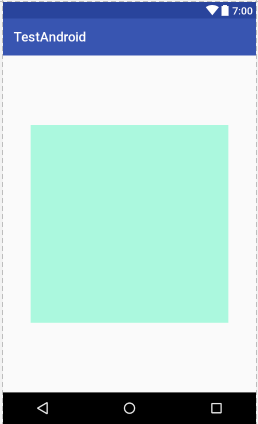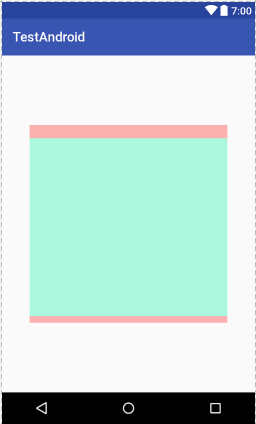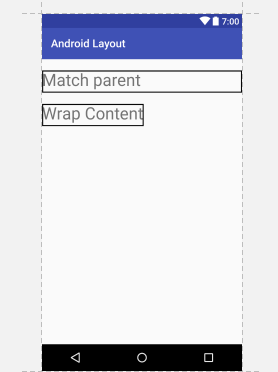I'm a little confused about two XML properties: match_parent and fill_parent. It seems that both are the same. Is there any difference between them?
They're the same thing (in API Level 8+). Use match_parent.
FILL_PARENT (renamed MATCH_PARENT in API Level 8 and higher), which means that the view wants to be as big as its parent (minus padding)
...
fill_parent: The view should be as big as its parent (minus padding). This constant is deprecated starting from API Level 8 and is replaced bymatch_parent.
http://developer.android.com/reference/android/view/ViewGroup.LayoutParams.html
-1. I you feel better about it, I don't get the impovement in that either... :-) –
Shig -1. You get the error because the older platform does not know about the new name of the very same constant. –
Blueprint Google changed the name to avoid confusion.
Problem with the old name fill parent was that it implies its affecting the dimensions of the parent, while match parent better describes the resulting behavior - match the dimension with the parent.
Both constants resolve to -1 in the end, and so result in the identical behavior in the app. Ironically enough, this name change made to clarify things seems to have added confusion rather than eliminating it.
Functionally no difference, Google just changed the name from fill_parent to match_parent, from API level 8 (Android 2.2). FILL_PARENT is still available for compatibility reason.
LayoutParams.FILL_PARENT and LayoutParams.MATCH_PARENT both have value -1. Not sure what tempted google to change from Fill Parent to Match Parent :)
Since most of the phones are >= Android 2.2 .. you should use Match Parent for future compatibility... not sure when they will discontinue the older Fill Parent constant!
FILL_PARENT is deprecated in API level 8 and MATCH_PARENTuse higherlevel API
match_parent is used in place of fill_parent and sets it to go as far as the parent goes. Just use match_parent and forget about fill_parent. I completely ditched fill_parent and everything is perfect as usual.
Check here for more.
Both have similar functionality only difference is that fill_parent is used up to API level 8 and match_parent is used after API level 8 or higher level.
When you set layout width and height as match_parent in XML property, it will occupy the complete area that the parent view has, i.e. it will be as big as the parent.
<LinearLayout
android:layout_width="300dp"
android:layout_height="300dp"
android:background="#f9b0b0">
<TextView
android:layout_width="match_parent"
android:layout_height="match_parent"
android:background="#b0f9dc"/>
</LinearLayout>
Hare parent is red and child is green. Child occupy all area. Because it's width and height are match_parent.
Note : If parent is applied a padding then that space would not be included.
<LinearLayout
android:layout_width="300dp"
android:layout_height="300dp"
android:background="#f9b0b0"
android:paddingTop="20dp"
android:paddingBottom="10dp">
<TextView
android:layout_width="match_parent"
android:layout_height="match_parent"
android:background="#b0f9dc"/>
</LinearLayout>
So TextView hight = 300dp(parent hight) - (20(paddingTop)+10(paddingBottom)) = (300 - 30) dp = 270 dp
fill_parent Vs match_parent
fill_parent is previous name of match_parent
For API Level 8 and higher fill_parent renamed as match_parent and fill_parent is deprecated now.
So fill_parent and match_parent are same.
API Documentation for fill_parent
The view should be as big as its parent (minus padding). This constant is deprecated starting from API Level 8 and is replaced by {@code match_parent}.
Just to give it a name closer to it's actual action. "fill_parent" does not fill the remaining space as the name would imply (for that you use the weight attribute). Instead, it takes up as much space as its layout parent. That's why the new name is "match_parent"
match_parent and fill_parent are same property, used to define width or height of a view in full screen horizontally or vertically.
These properties are used in android xml files like this.
android:layout_width="match_parent"
android:layout_height="fill_parent"
or
android:layout_width="fill_parent"
android:layout_height="match_parent"
fill_parent was used in previous versions, but now it has been deprecated and replaced by match_parent.
I hope it'll help you.
fill_parent: The view should be as big as its parent.
now this content fill_parent is deprecated and replaced by match_parent.
match_parent, which means that the view wants to be as big as its parent (minus padding).
wrap_content, which means that the view wants to be just big enough to enclose its content (plus padding)
For sake of better illustration, I have created a sample layout that demonstrate this concept. To see it's effect, I added a border of each textView content.
In "Match parent" textView content, we can see it's layout width spread out of it's parent whole length.
But we can see in "Wrap Content" textView content, it's layout width wrapped in of it's content(Wrap Content) length.
match_parent (which you covered) and fill_parent (which you didn't address). You instead compaed it to wrap_content, which the question doesn't ask about. –
Willaims To me fill parent and match parent performs the same function only that:
fill parent: Was used before API 8
match parent This was used from API 8+ Function of Both Fills the parent view aside the padding
FILL_PARENT was renamed MATCH_PARENT in API Level 8 and higher which means that the view wants to be as big as its parent (minus padding) - Google
FILL_PARENT is deprecated from the API level 8 and higher and it is renamed for the upper versions as MATCH_PARENT
Both are same FILL_PARENT and MATCH_PARENT,FILL_PARENT was used in the lower version less than API level 8 and MATCH_PATENT are used in higher API level greater than 8.
FILL_PARENT (renamed MATCH_PARENT in API Level 8 and higher), which means that the view wants to be as big as its parent (minus padding)
fill_parent: The view should be as big as its parent (minus padding). This constant is deprecated starting from API Level 8 and is replaced by match_parent.
For more details please visit this page
Both, FILL_PARENT and MATCH_PARENT are the same properties. FILL_PARENT was deprecated in API level 8.
They're the same thing (in API Level 8+). Use match_parent.
Both FILL_PARENT and MATCH_PARENT are the same properties. FILL_PARENT was deprecated in API level 8.
1. match_parent
When you set layout width and height as match_parent, it will occupy the complete area that the parent view has, i.e. it will be as big as the parent.
Note : If parent is applied a padding then that space would not be included.
When we create a layout.xml by default we have RelativeLayout as default parent View with android:layout_width="match_parent" and android:layout_height="match_parent" i.e it occupies the complete width and height of the mobile screen.
Also note that padding is applied to all sides,
android:paddingBottom="@dimen/activity_vertical_margin"
android:paddingLeft="@dimen/activity_horizontal_margin"
android:paddingRight="@dimen/activity_horizontal_margin"
android:paddingTop="@dimen/activity_vertical_margin"
Now lets add a sub-view LinearLayout and sets its layout_width="match_parent" and layout_height="match_parent", the graphical view would display something like this,
match_parent_example
Code
xmlns:tools="http://schemas.android.com/tools"
android:layout_width="match_parent"
android:layout_height="match_parent"
android:paddingBottom="@dimen/activity_vertical_margin"
android:paddingLeft="@dimen/activity_horizontal_margin"
android:paddingRight="@dimen/activity_horizontal_margin"
android:paddingTop="@dimen/activity_vertical_margin"
tools:context="com.code2care.android.togglebuttonexample.MainActivity" >
android:layout_width="match_parent"
android:layout_height="match_parent"
android:layout_alignParentLeft="true"
android:layout_alignParentTop="true"
android:layout_marginLeft="11dp"
android:background="#FFFFEE"
android:orientation="vertical" >
2. fill_parent :
This is same as match_parent, fill_parent was depreciated in API level 8. So if you are using API level 8 or above you must avoid using fill_parent
Lets follow the same steps as we did for match_parent, just instead use fill_parent everywhere.
You would see that there is no difference in behaviour in both fill_parent and match parent.
© 2022 - 2024 — McMap. All rights reserved.



